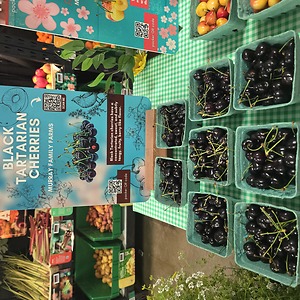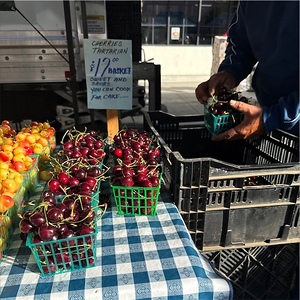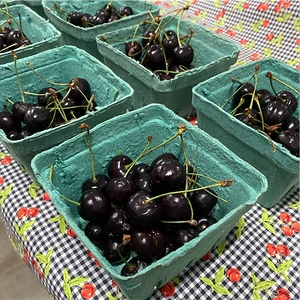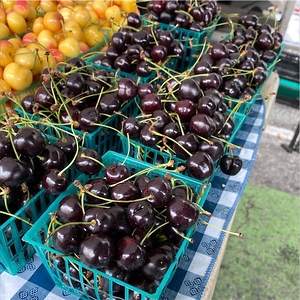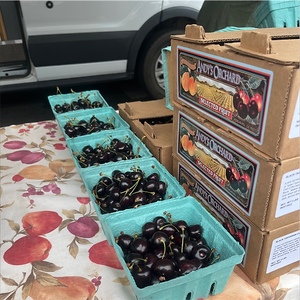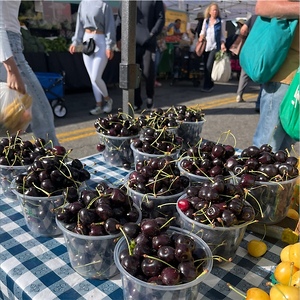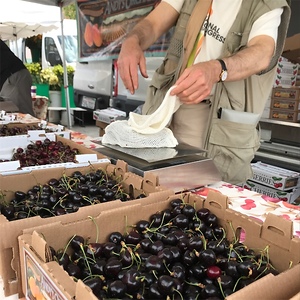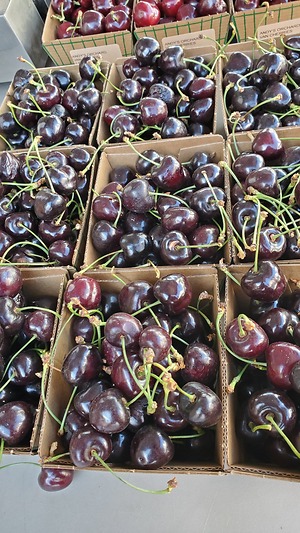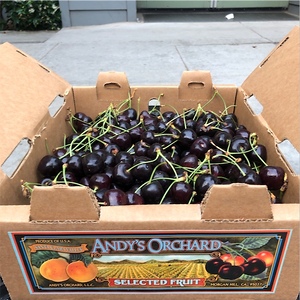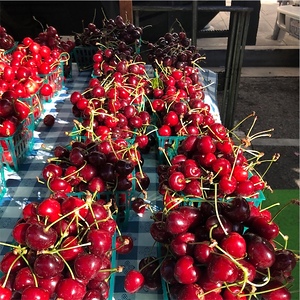

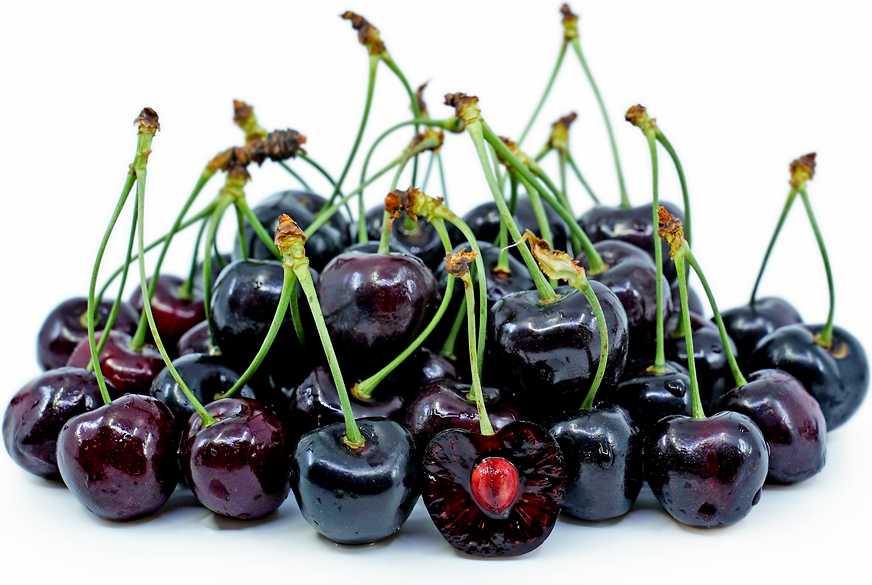
Black Tartarian Cherries
Estimated Inventory, lb : 0
This item was last sold on : 06/11/25
Description/Taste
Black Tartarian cherries are a medium to large varietal, averaging 2 to 3 centimeters in diameter, and have a round, ovate, to cordate shape with a slight depression where the stem connects to the fruit. The cherry’s skin is smooth, taut, glossy, and thin, ranging in color from red-purple to dark purple, almost black. The green stem is connected to the top of the fruit and is slender, fibrous, and pliable. Underneath the surface, the flesh is dark red to purple-black and is semi-firm, aqueous, and crisp with a tender, sometimes soft consistency. The flesh also encases a central light brown pit that does not adhere and is easily removed. Black Tartarian cherries have a concentrated, sweet, and subtly tangy, fruity, berry-like flavor. In the late spring, the trees also bear small and ruffled, five-petaled blossoms that are highly ornamental, emitting a sweet fragrance.
Seasons/Availability
Black Tartarian cherries are available in the late spring through early summer.
Current Facts
Black Tartarian cherries, botanically classified as Prunus avium, are an early-season variety belonging to the Rosaceae family. The sweet heirloom cultivar grows on trees that can reach 4 to 9 meters in height, available in dwarf and full-size, and is favored for its berry-like, rich flavor and soft, juicy texture. Black Tartarian cherries were originally from Russia and were introduced to the United States in the 18th century. The variety is also known as Ronald’s Large Black Heart, Black Tartan, Black Russian, Fraser’s Black Tartarian, and Circassian Black, and was once a widely grown home garden cultivar. Black Tartarian cherry trees produce high yields, are hardy, and have an easy-to-grow nature, adapting well to many different soil types. This has allowed the variety to be planted worldwide, and the fruits provide a full-bodied flavor and color for fresh-eating and cooked preparations. Despite their once prevalent fame, Black Tartarian cherries were difficult to ship due to their thin skin and soft, aqueous nature. Over time, they eventually fell out of commercial cultivation in favor of newer cherry varieties. In the modern-day, Black Tartarian cherries are still found in home gardens worldwide and are used as a pollinator in orchards for other dark sweet cherry varieties.
Nutritional Value
Black Tartarian cherries are an excellent source of anthocyanins, pigments found in the skin and flesh that give the fruits their dark purple-red coloring. These pigments contain antioxidant-like properties to reduce inflammation and protect the cells against free-radical damage. The cherries also provide vitamin C to boost the immune system, vitamin A to maintain healthy organ functioning, and other amounts of phosphorus, potassium, calcium, and B vitamins.
Applications
Black Tartarian cherries have a semi-sweet, fruity flavor well suited for both fresh and cooked preparations. The fruits can be consumed straight, out of hand, discarding the pits, or they can be tossed into fruit salads, green salads, and grain bowls. It is important to note that the deep pigmentation of the juice may permanently stain fabric and temporarily color the lips and skin. Black Tartarian cherries can also be chopped into salsa, stirred into a parfait, yogurt, and oatmeal, or juiced for mixed drinks, punches, and smoothies. In addition to fresh preparations, Black Tartarian cherries can be baked into bread, scones, doughnuts, and muffins, or they can be blended into ice cream, cooked into preserves, or used as filling for pies, cakes, and bars. The fruits have juicy flesh that tends to bleed, imparting a magenta hue to dishes. Black Tartarian cherries can also be cooked into sauces and syrups or infused into vinaigrettes, oils, and dressings. Black Tartarian cherries pair well with vanilla, caramel, cinnamon, fruits such as plums, apricots, berries, and peaches, meats including poultry, turkey, pork, and fish, and nuts such as almonds, pecans, and cashews. Whole, unwashed cherries will keep up to one week when stored between paper towels in the coldest part of the refrigerator. The fruits can also be kept in sealed plastic bags and frozen for extended use.
Ethnic/Cultural Info
Black Tartarian cherries are popularly pickled in Russia to extend the fruit’s shelf life. Russia is known for having a short summer season, and the cherries are often grown in family gardens, also referred to as dachas. Each Black Tartarian cherry tree produces high yields, providing families with a surplus of fresh fruits. To preserve the fruits for the cold winter season, pickling is a common food preservation technique utilized throughout Russia. The sweet cherries are pickled in a sweet and sour brine and flavored with spices such as nutmeg, allspice, cardamom, and cinnamon. Once infused, the pickled cherries develop a sweet-tart, tangy flavor well suited for both sweet and savory preparations. Pickled cherries are traditionally incorporated into salad dressings and balance flavors when paired with fatty, roasted meats. The pickled fruits are also widely favored for retaining their semi-firm texture and can be stored for up to one year.
Geography/History
Black Tartarian cherries are native to the Circassia region, located in the North Caucasus of Southwestern Russia. The variety was brought from Russia to England in 1794 through horticulturalist Hugh Ronalds and was initially known as Ronald’s Large Black Heart. Black Tartarian cherries were also later introduced into European commercial markets under the name Fraser’s Black Tartarian. In the early 19th century, Black Tartarian cherries were transported from Europe to the United States through nurseryman William Prince Sr. and were sold through his nursery in Long Island, New York. The variety was recognized as a cultivar in American markets in 1848 and quickly became a favored home garden cherry tree planted across the country. Today Black Tartarian cherries are challenging to find in commercial settings due to their thin skin. When in season, the cherries are sold through farmer’s markets and are also harvested from home garden trees.
Recipe Ideas
Recipes that include Black Tartarian Cherries. One
Podcast



